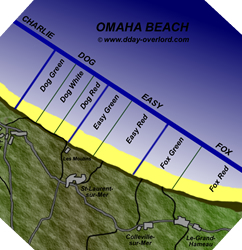Omaha Beach
History and photos of the beach – 1/2
|
– Location: from Pointe du Hoc to Sainte-Honorine – Schedule: 06:30 am – D-Day |
– Allied unit: – German unit: 352. Infanterie-Division |
Omaha Beach is one of the two American landing areas in Normandy. 5.9 kilometers long, this beach is 12 kilometers east of Utah Beach. It consists of the towns of Vierville-sur-Mer in the west, Saint-Laurent-sur-Mer in the center and the villages of Colleville-sur-Mer and Le-Grand-Hameau in the east. This beach is originally called the Côte d’Or (golden coast). A plateau overlooks the shore and four valleys allow to reach the interior.

Omaha Beach map
(Click on picture to enlarge)
Mass in England before embarkation on the ships that will leave for Omaha Beach. Photo: US National Archives
- Committed units
The 16th Regiment of the 1st US Infantry Division and the 116th Regiment of the 29th US Infantry Division are designated to attack this beach, divided into four major landing areas. They are named, from the west to the east: “Charlie”, “Dog”, “Easy” and “Fox”. Depending on the progress of the Pointe du Hoc attack programmed at the same time, these units can be reinforced by the 2nd and 5th battalions of Rangers.
USS Augusta and landing craft en route to Omaha Beach. Photo: US National Archives
These military formations are under the command of Major General Leonard T. Gerow, commander of the 5th US Army Corps, and General Omar N. Bradley, commander of the 1st US Army.
- The bombings
All night before the American amphibious attack on Omaha, many Allied bombers dropped hundreds of tons of bombs on German beach defenses. But in Omaha, the precision of the bombing is terribly lacking: disabled by a very strong fog and by low clouds, the bombers drop their bombs a few seconds too early or too late. The result is catastrophic for the Allies: the 13,000 dropped bombs miss their targets and explode inland, a few kilometers from the beaches.
Assault waves head towards the beach. Photo: US National Archives
In the early morning, thick smoke due to the bombing of the night masks the coast to the allied ships. At dawn, the shooting of naval artillery directed towards the Atlantic wall is as imprecise as the drops of the bomber planes. The Germans are tried by these bombardments, but their losses are very low, as much in human lives as in material. For their part, the American soldiers saw the coast burning and lit up with a thousand lights during the naval bombardment, and they thought that the Germans were crushed under tons of land.
These American soldiers, squatting in their landing craft, wait in the approach phase. Photo: US National Archives
- The assault
The first wave of assault arrives at 06:35: 1,450 soldiers who are distributed in 36 landing craft. The tide is low and it discovers the mined piles installed a few months ago. On the other hand, the assailants had to cover 500 meters uncovered before being able to take cover.
Worried, the occupants of the landing craft observe the fighting on the beach. Photo: US National Archives
The Germans, standing ready to defend their positions, await the last moment to open fire in order not to immediately reveal their positions. As soon as the landing craft hit the beach and the soldiers tread the ground in France, a shower of shells and machine-gun bullets fell upon them. The first assault wave is in an instant decimated: in the first five minutes of the assault, nearly 90% of its forces are put out of action. The vast majority of officers and non-commissioned officers are wounded or killed and the survivors organize themselves as they can in small groups, usually by affinity or by geographical origin: the Texas G.I.s find themselves between Texans, etc.
The landing crawl dropped, the G.Is departed to fight. Photo: US National Archives
- The tanks tragedy
American landings in Omaha receive unequal support from tanks, unlike soldiers in Utah or on Anglo-Canadian beaches. 112 tanks (amphibious Duplex Drive “DD” Sherman, Sherman tanks equipped with snorkels and Sherman bulldozers) belonging to the 741st and 743rd Tank battalions are scheduled to land at 6:30 am on Omaha to support the infantry.
On 6 June, starting at 3 am, 64 Sherman DD tanks were to be launched and then to reach the coast by their own means. The other tanks are planned to be landed directly on the beach, in accordance with the assault plan.
Photo of the landing on Omaha taken by the US Coast Guard. Photo: US National Archives
The amphibious Duplex Drive tanks belonging to the 741st Tank Battalion (TB) are in charge of supporting the 16th Infantry Regiment (1st Infantry Division) in front of Colleville-sur-Mer. But the sea is unleashed and these tanks, designed to sail in calm weather, do not withstand the very strong swell. All the tanks of the C company, that is to say 16 tanks, sank in the English Channel. 13 of the 16 tanks from B company also sank. After the first of the four DDs aboard LCT (6)-600 sank, Ensign Henry Sullivan made the decision to transport the other three tanks from B company directly on the beach. For the 741st TB, 5 amphibious DD tanks, 6 tanks equipped with snorkels and 5 bulldozer tanks manage to reach the shore. Unfortunately, many crews sank with their tank.
The 743rd Tank Battalion decides to operate otherwise and to disembark its tanks directly on the Dog Green and Dog Red beaches facing Vierville-sur-Mer, at the risk of losing or damaging the transport ships: the LCT (Landing Craft Tank) approach the shore and manage to regain the open sea without too much hassle. 32 Sherman DD, 7 tanks equipped with snorkel and 3 Sherman bulldozers of the 743rd TB are engaged on the beach.
A total of 58 tanks reached the mainland at Omaha Beach. As of 7 am, 14 of them were already destroyed or abandoned. The others are blocked on the beach by the anti-tank wall or skate on the pebbles. Lacking firepower, the infantrymen are unable to silence the German defensive positions. The tanks of 741st TB are particularly attractive to enemy fires and only three of them are still operational at the end of the day.
In front of the Ruquet strongpoint, the Americans, supported by three D.D. tanks, progress. Photo: US National Archives
The landed troops find their salvation behind the anti-tank wall in front of a ledge (which can measure up to 185 meters wide in one place), itself located at the foot of the plateau that overlooks the beach. This anti-tank wall is of variable height but is high enough for a man to squat without being spotted by the Germans in their casemates. At the extreme west of Omaha beach, in front of Vierville-sur-Mer, “Charlie” sector, the anti-tank wall is replaced by a natural rampart formed by pebbles. American soldiers are obliged to remain lying there if they do not want to be targeted. But German mortar shells still manage to kill behind this meager protection.
Lying behind the “asparagus of Rommel” and the “Czech hedgehogs”, the soldiers try to protect themselves from the enemy fire. Photo: Robert Capa
Back to the Normandy landing beaches menu











